Although Dubai’s infrastructure is still continuously improving to satisfy the rapidly growing population and the thousands of tourists visiting the city, it already has an effective transport system.
The Roads and Transport Authority (RTA), launched by the government in 2005, has the responsibility for controlling all the transport and traffic projects in Dubai.
Despite the fact that Dubai is not really designed for pedestrians, it has a quite sufficient public transport system with numerous options for getting around.
Arriving in the city, you can easily get a quite cheap taxi with excellent service right in front of the airport, or you can opt for renting a car.
The public transport facilities are also excellent in Dubai so while travelling around you can choose from any of the transport vehicles including metro, tram, monorail, bus or even water taxi.
Road network and address system
At first sight, Dubai’s road system looks quite complicated, but it will not take too long for you to find your way around the city either. Dubai has broad highways to accommodate the massive traffic flow, and they are connecting the city to other emirates. These roads are marked with E, and their emblem is a falcon. These main highways are the following:
- E11: Sheikh Zayed Road – runs from Sharjah to Abu Dhabi parallel to the sea and it also connects to the highly visited areas such as Dubai Creek, Downtown Dubai, Jumeira, Palm Jumeirah and Dubai Marina
- E44: Al Khail Road – runs from Sports City to Ras Al Khor then turns and continues towards Hatta and Oman
- E311: Sheikh Mohammed Bin Zayed Road – connects Abu Dhabi to Sharjah
- E611: Emirates Road, also known as Outer Ring Road or Dubai Bypass Road – links Abu Dhabi to Ras Al Khaimah (another emirate in the UAE)
- E66: Oud Metha Road – connects Dubai to Al Ain
Dubai’s narrower roads and streets connect the localities within the city. They are marked with D, and their emblem is a fort. Some of the important roads are:
- D63: Umm Suqeim Road
- D69: Al Hadiqa Street/Muscat Street
- D71: Financial Center Road
- D73: Al Dhiyafa Road/2nd December Street
- D75: Sheikh Rashid Road
- D85: Baniyas Road
- D89: Al Maktoum Road/Airport Road
- D92: Al Khaleej Road/Al Wasl Road
- D94: Jumeirah Road
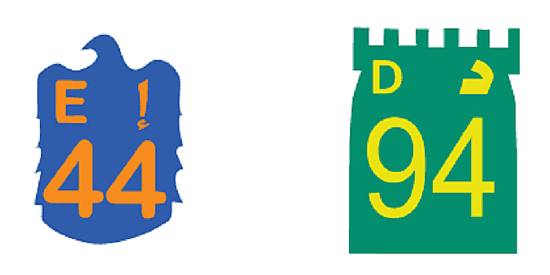
As you noticed above some roads and areas have two different names, sometimes two streets have the same name or number, and you might not find postcode either.
Dubai is just introducing an integrated address system due to the growing population and the expanding city to replace this confusing system.
This addressing project includes dividing the city into districts and further into smaller communities, renaming streets and creating proper addresses (with building number, street name, community and district)
Along with the continuously improving infrastructure, there is a growing population with thousands of visitors which adds to the traffic jams.
One of the projects to decrease the congestions is the allocation of separating lanes for Dubai Buses and Taxis.
These roads are selected according to the highly populated areas and the designated lanes are clearly marked with yellow color:
- Al Mankhool Road (Al Satwa roundabout up to Sheikh Rashid Road)
- Al Khaleej Road (near Khalid bin Al Waleed Road Intersection up to Al Musalla Road opposite to Hyatt Regency Hotel)
- Khalid bin Al Waleed Road
- Al Ghubaiba Road

On Foot
Although the city is generally car-oriented and not well-designed for pedestrians, there are several walkways throughout the city.
You can take a walk around marina on the Marina Walk or enjoy the fresh air near the sea at The Walk JBR, and you can also choose to take a stroll along the Dubai Creek and the souk area.
You can also spend time in the city’s numerous of parks and beaches as well.
Despite the pavements all around the city, it is not recommended to walk from district to district because of the long distance. If you still want to enjoy the pleasant weather but tired of walking you can try out the public bike sharing system.
Bike sharing system
Before you rent a bike, you should be aware of that it is not allowed to cycle on highways, and it is required to wear a helmet and a high-visibility jacket. If you break these rules, you might end up paying an AED 500 fine.
How it works
Renting for the first time requires a registration process, but in the future, you can easily rent any bike in any city which is using this sharing system.
Once you unlock the bike with either calling the hotline, using your phone application or your customer card, you are allowed to take the bike.
The sharing system works on a duration basis; the bikes can be rented from 30 minutes up to 24 hours.
After usage, the cycles have to be returned to the official locations (any of them, not only the starting point), and the procedure ends in the same way as you took the rental bike, in addition with payment.
The public bike docking stations are available in four districts in the city including:
- Downtown Dubai
- Jumeira
- Palm Jumeirah
- Dubai Marina
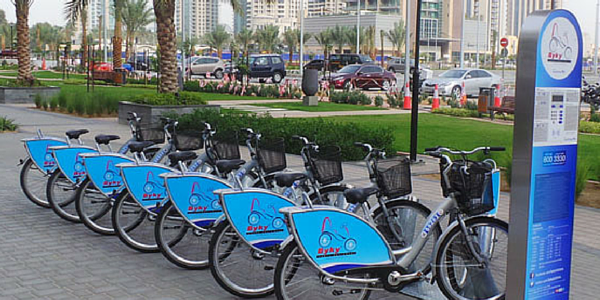
Prices
The price of renting a bike vary according to the duration of the rental and it starts from AED 15 for a 30 minute trip and can go up to AED 80 for 24 hours.
In case you need more information about the bike sharing system, you can visit their official website.
Public transportation
Dubai’s population is rapidly growing and with the influx of thousands of visitors each year, the government has made it its priority to improve the infrastructure and reduce the traffic congestions.
While around ten years ago there was no public transportation in the town, today you can choose from several modes of transport throughout the city thanks to the Roads and Transport Authority (RTA), launched by the government in 2005.
NOL Card
Most of the means of RTA public transportation will not allow you to pay by cash. Instead, the introduced NOL card is used for paying the fares.
This rechargeable smart card stores the credit that has to be added before traveling and the fare will be calculated and automatically deducted from the card based on the number of the travelled zones.
It works on ‘touch and go’ basis which means that you have to tap it on the entry and exit points of the RTA transportation services.
The card is available in different types and can be purchased and topped up in several places.
You can use these credit-card-sized cards for:
- Dubai Metro
- Dubai Tram
- Bus
- Abra
- Water bus
- In some taxis
- Paid parking zones
You can purchase and top up your card at the following places:
- Ticket offices:
- Airport Terminal 1, 2, 3
- Bus stations: Al Ghubaiba, Gold Souq, Jebel Ali and Sabkha bus stations
- Ticket vending machines:
- all the metro stations
- at the major bus stops and stations
- Authorized sales agents:
- Locations in Carrefour: Deira City Centre, Mall of the Emirates, Shindagha
- 20 Locations in Redha Al-Ansari Exchange
- 18 locations in Spinneys
- Waitrose, Dubai Marina Mall
- City Group
- Grand City Mall
- Lulu International Exchange LLC
- RTA Customer Service Centers:
- Al Awir License Branch
- Al Barsha License Branch
- Al Karama License Branch
- Al Towar License Branch
- Aswaq Mezher License Branch
- Customer Service Main Office
- Dubai Industrial City License
- Licensing Department Deira
- Jumeirah Plaza
- Online: www.nol.ae
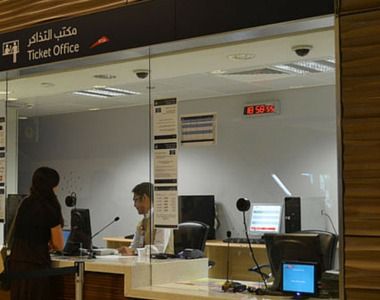
Types of NOL card
There are four types of NOL cards available:
Red
- It is a paper ticket which can be loaded up to 10 trips or 5 daily passes.
- Beneficial for: tourists and occasional travelers.
- It can be used on metro, tram, bus, abra and water bus; but only on one mode of transportation at a time.
- Validity: 90 days.
- The cost of the ticket: AED 2.
- Minimum balance to start a journey: 1 trip or 1 daily pass.
- Where to buy: ticket offices and some of the ticket vending machines.
- Where to top up: ticket vending machines.

Blue
- It is a personalized card with the user’s photo and it can hold up to AED 500.
- Beneficial for: frequent travelers (only for residents).
- It can be used on metro, tram, bus, water bus, and parking.
- Validity: 5 years.
- The cost of the card: AED 70 for standard and AED 80 for gold class (added value on card: AED 20).
- Minimum balance to start a journey: AED 7.5.
- Where to buy: ticket offices, online.
- Where to top up: ticket offices, ticket vending machines, authorized sales agents, RTA Customer Service Centers, online
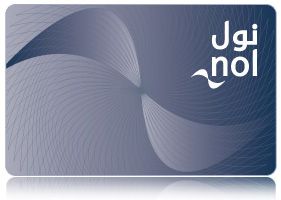
Silver
- It is an anonymous card which can be loaded up to AED 500.
- Beneficial for: casual users and occasional travelers.
- It can be used on metro, tram, bus, water bus, and parking.
- Validity: 5 years.
- The cost of the card: AED 25 (added value on card: AED 19).
- Minimum balance to start a journey: AED 7.5.
- Where to buy: ticket offices, some of the ticket vending machines, authorized sales agents, RTA Customer Service Centers.
- Where to top up: ticket offices, ticket vending machines, authorized sales agents, RTA Customer Service Centers, online.

Gold
- It is a smart card which can hold up to AED 500.
- Beneficial for: the ones preferring gold class cabins.
- It can be used on metro, tram, bus, water bus, and parking.
- Validity: 5 years.
- The cost of the card: AED 25 (added value on card: AED 19).
- Minimum balance to start a journey: AED 7.5.
- Where to buy: ticket offices.
- Where to top up: ticket offices, ticket vending machines, authorized sales agents, RTA Customer Service Centers, online.
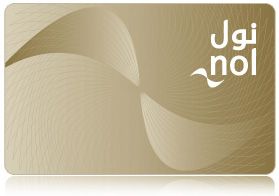
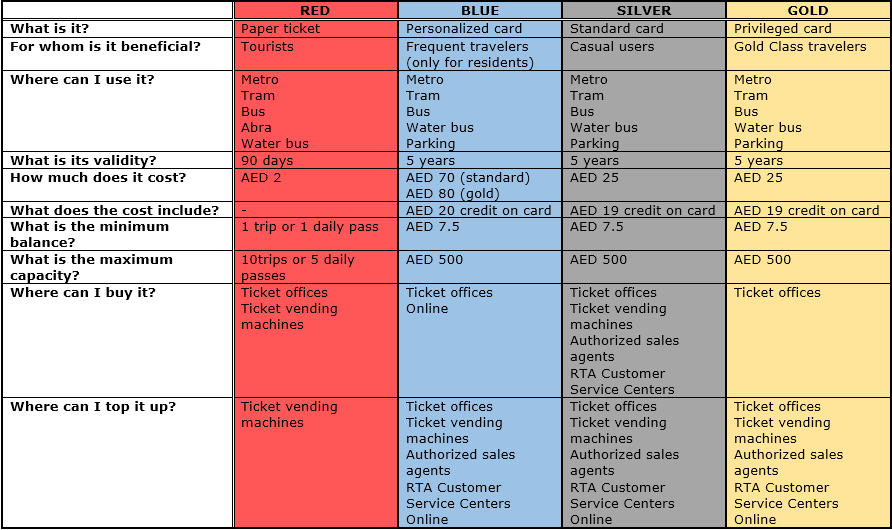
Remarks:
- T1: journey within 1 zone or less than 3 kilometers (crossing 2 zones).
- T2: single trip starts in one zone and ends in the neighboring one.
- T3: journey crosses more than 2 zones.
- Time allowed between transfers: 30 minutes.
- Single trip maximum transfers: 3.
- 50% discount is applicable only for residents in the status of being students (age from 5 to 23 years), seniors or physically challenged.
- Children below the age of 5 and the height of 9 cm can travel for free without a card.
- One-day pass is available only for Red ticket holders.
- 30, 90, 365-day passes are available only for Blue card holders (only for residents).
- Tourists and visitors can use Red ticket, Silver or Gold card.
- These prices are applicable on metro, bus and tram. Abra, water bus, taxi and parking have different pricing which is mentioned in the related chapters.
How to use the NOL card?
- Choose (red, blue, silver, gold) and purchase the right card.
- Top up your card with the required amount (see chart above).
- Approach the entry gate/entrance and place the card on the reader.
- Pass through the gate/entrance after getting the beep sound or the green light.
- Finish your journey by placing your NOL card at the exit gate/exit door.
- The machine will then show you the cost of your trip and the remaining balance on your card.
- You can pass through the gate/door once you get the beep sound or the green light.
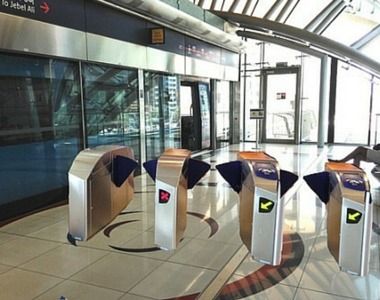

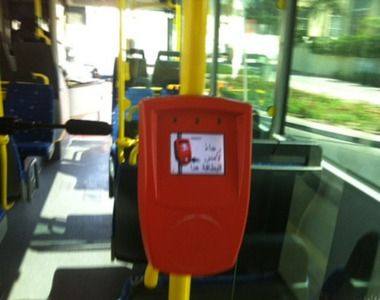
If you wish to know more about NOL cards, please visit their official website by clicking here.
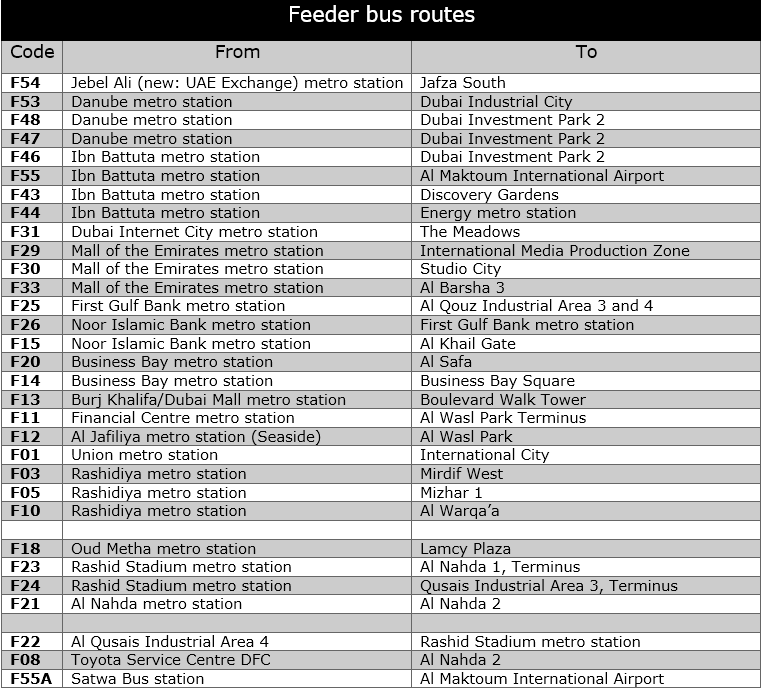
Metro to taxi
Taxi pick up and drop off zones are present close to the metro stations.
Metro to car
There are three large multi-level car parking available for the passengers to park their car and ride the metro. These parking lots can be found at the following stations:
Line Station Capacity
Red Line Rashidiya metro station 2700 cars
Red Line Nakheel Harbour and Tower metro station 3000 cars
Green Line Etisalat metro station 2300 cars
The parking is free of cost for the metro users.
Metro to flight
The Dubai Metro (Red Line) even connects to the Dubai International Airport: at Airport Terminal 3 and Airport Terminal 1 stations.
Timing
The Dubai Metro operates seven days a week. From Saturday to Wednesday trains run from 5:30 AM to 12:00 AM-midnight on the Red Line and from 5:50 AM to 12:00 AM-midnight on the Green Line.
On Thursday, the opening hours are the same, but the metro operates till late night, 1:00 AM on both lines while the opening hours change to 10:00 AM and trains run till late night, 1:00 AM on Friday.
Passengers do not have to wait for trains for a long time even if they do not have a timetable because the trains arrive to stations quite frequently.
Trains run every 4 minutes during peak time (on weekdays: 6:30-8:30 AM, 12:30-2:00 PM, 5:30-9:00 PM), and every 7 minutes during off-peak hours.
The average travel time between stations is 60-90 seconds with 20-30 seconds of stopping time at each station.
The entire journey from the first to the last station on the Red Line takes around 1 hour and 10 minutes while it takes around 40 minutes on the Green Line.
Fares
The Dubai Metro is under the control of the Roads and Transport Authority (RTA), therefore, cash is not accepted while using the metro, instead, the NOL card has to be used by passengers to check in and check out at the gates of the stations.
This smart card has to be purchased and topped up with at least the minimum amount before traveling by public transportation.
They are available at ticket offices and ticket vending machines. Before you choose from different types of cards, please consider the following things:
- tourists can have only Red, Silver or Gold NOL Card; the Blue card is available only for residents
- the NOL Red Ticket is ideal for tourists and occasional travelers but can be used only on one mode of transport at a time and has a maximum validity of 90 days
- NOL cards (Silver and Gold) are ideal for frequent travelers, but it is also recommended for visitors in case of a wish to use different means of transportation during their stay (it is valid for five years)
- the fare is calculated according to the number of zones crossed during the trip and the type of the card (travelling within a zone can cost AED 3 with Red Ticket, AED 4 with Silver and AED 6 with Gold Card while a journey within 3 zones can go up to AED 8.5 with Red Ticket, AED 7.5 with Silver and AED 15 with Gold Card)
The NOL Red Ticket and NOL Cards can be used on metro, tram, bus, water bus and paid parking.
All you need to do is to place the card on the reader at the entry gate or entrance door when hopping on and repeat the same procedure at the exit gate or exit door when hopping off the vehicle.
The fare will be automatically deducted from your ticket/card based on the number of zones crossed during the journey. In case you forget to check out, the maximum fare will be charged.
The balance of your ticket/card is shown on the reader when checking in or out but can be monitored in vending machines and ticket offices as well.
Passengers can use the metro and bus with the same fare and not charged more in case they can get on the bus within 30 minutes and vice versa. Children below the age of 5 or less than 90 centimeters can travel for free.
If you wish to know more about NOL cards, fares and passes, please check out the related content.
Rules
In the case of using Dubai Metro the following rules have to be followed:
- Do not push others and do give way to other people
- Priority must be given for elderly, injured, special needs and pregnant passengers
- Accessing and using special designated areas (for example women and children only cabin) is forbidden
- Animals are not allowed in any means of transportation, except guide dogs for people visually impaired
- Eating (even chewing gum), drinking, spitting, littering and smoking is not allowed
- Resting feet on seats is restricted and will result in fine
- Using invalid, expired or other person’s card is forbidden
- Leaving without payment will result in fine
- Selling or promoting goods is prohibited
- Sleeping in bus shelters is forbidden
- It is not allowed to carry alcohol and hazardous items
- Vandalism is strictly prohibited
Future plans
Due to the increasing demand of the usage of the metro and the Expo 2020 the government has announced that the Dubai Metro tracks have to be extended. There are plans to extend the existing lines (the Red and the Green) further and to build more new lines.
The major expansion of the Red Line extends the existing track with 15 more kilometers (6 new stations) from the UAE Exchange station towards Abu Dhabi while on the other end from Rashidiya station to City Centre Mirdif with 3.5 more kilometers with a new station.
The Green Line construction plan is to add 12 stations, 21 more kilometers from Al Jadaf station to Academic City while crossing Festival City, Lagoons, Ras Al Khor, International City and Silicon Oasis in order to improve the transport options for the residents living in these areas.
The government also set a plan to build four more new lines to improve the connectivity of the whole city. The Purple and the Blue Line’s purpose would be to connect the two airports – the Dubai International Airport and the Dubai World Central/Al Maktoum International Airport – along Al Khail Road (purple) and Sheikh Mohammed Bin Zayed Road (blue). The one and only east-west running metro track would be the Pink Line from Al Sufouh (Jumeira) to Dubailand while the Gold Line is planned to link Dubai Marina to Dubailand and Dubai Creek.
Although there are many metro projects scheduled for the future till 2030, the government has already started building the lines in order to fulfill the plans.
Tram
The Dubai Tram is a railway that runs 10.6 kilometers along the Dubai Marina and Jumeira districts’ public streets until the final station at the tram depot, next to Dubai Police Academy. This mode of public transportation opened for public on 12th of November in 2014 and with its integration to the transport network, it made the nearby attractions (like Dubai Marina Mall, Jumeirah Beach Residence or The Walk JBR) easily accessible.
The tram is driven by a certified driver who has to pass the alcohol test each time before driving the carriage. The tram also has a Dead man’s switch feature (a button which has to be pressed in every 5 seconds to test the driver’s attention) to secure safety.
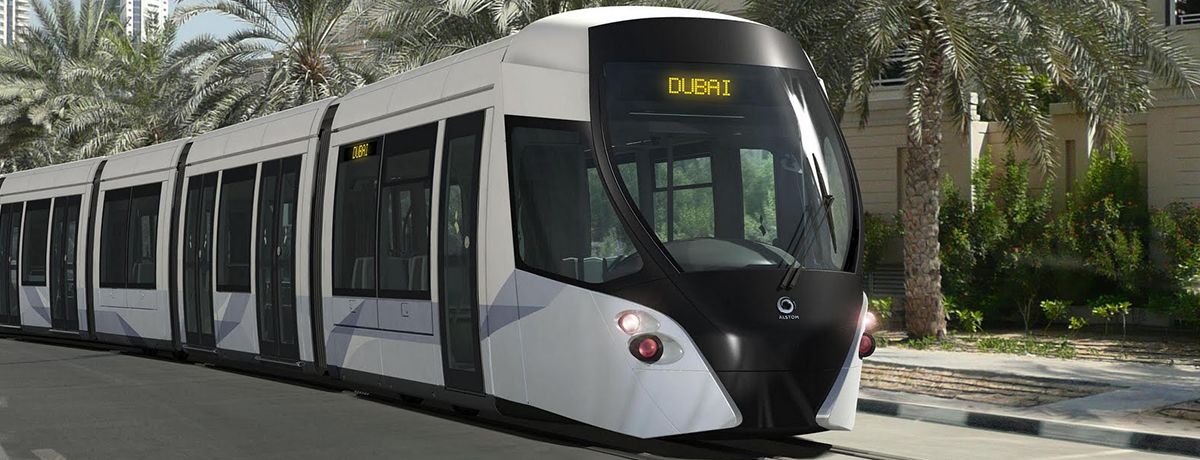
Features of Dubai Tram:
- It has a capacity of up to 405 passengers.
- Automatic Platform Screen Doors – please do not touch or lean on the door while the tram is moving.
- There are seven cabins with three classes available on each tram (gold, silver and women & children classes), and it also has designated spaces for passengers with physical disabilities.
- Free WiFi.
- Number of currently operating trams: 11.
- Air-conditioned and clean stations and trams.
Please note that it is not allowed to eat, drink or smoke inside the tram and remain seated until the tram stops at the station.
Stations
Currently, there are 11 air-conditioned stations served by the tram.
These are the following:
- Jumeirah Beach Residence 1 station – first station of the tram network, and close to attractions like The Walk JBR and Jumeirah Beach Residence
- Jumeirah Beach Residence 2 station – it is also easy access to the Jumeirah Beach Residence and The Walk JBR
- Jumeirah Lakes Towers station – this station links to the red line metro
- Dubai Marina Mall station – closest station to Dubai Marina Mall and easy access to Marina Walk and the water taxi station
- Dubai Marina station – this station is another link to the red line metro
- Marina Towers station – located in the heart of Dubai Marina
- Mina Al Seyahi station
- Media City station
- Palm Jumeirah station – this station connects to the monorail and has a multi-level parking lot
- Knowledge Village station
- Al Sufouh station – last station of Phase I tramway
There are several interchange stations available through the tram track. The tram connects to the red line metro at two stations: at Dubai Marina tram station (the metro station name is: DAMAC) and at Jumeirah Lakes Towers station.
The tramway also links to the Palm Jumeirah monorail at the Palm Jumeirah tram station (the monorail station name is: Gateway). The one and only dedicated multi-level parking area through the tram track is also available at this station.
Footbridges have been constructed for the pedestrians to provide safe connectivity between the tram and metro, and the tram and monorail stations.
Most of the tram stations are within walking distance of the nearest bus stop and have easy access to the taxis as well.
Timing
The Dubai Tram operates 19 hours daily (except Friday – 16 hours). It runs every 6 minutes from 6:30 AM in the early morning to 1:30 AM late night from Saturday to Thursday and from 9:00 AM to 1:30 AM on Friday.
The entire round journey takes 42 minutes.
Fares
Since the tram is owned by the Roads and Transport Authority (RTA), the payment system is similar to the one used on metro or bus. The fares must be paid by the NOL card so do not forget to purchase one and to scan your card at the reader for checking in and checking out.
A ride will cost you AED 3 if you have silver and AED 4 if you have a red card in case of using the standard class regardless of the traveled distance because all the stations are in the same zone. The fare for passengers wish to use the gold class will be AED 6 in the case of having a gold and AED 8 in the case of having a red card. If you are interested to know more about NOL card, fares and passes, please check out this resource.
Future plans
The Dubai Tram’s construction is divided into phases. The above mentioned 11 stations served by 11 trams are part of the Phase I.
Phase II will extend the track by 4-5 kilometers with eight more stations served by 14 more trams. With this extension, the tram will link to more great attractions, like Souk Madinat Jumeirah, Burj Al Arab or Mall of the Emirates. The completion of Phase II is scheduled before 2020.
There is also Phase III planned which will extend the track along Jumeirah Road till 2nd December Street before 2025.
Monorail
The Dubai Monorail, opened on 30th of April in 2009, is a five and a half kilometers long railway, and its track has a single elevated rail.
The monorail runs along the trunk of the Palm Jumeirah, connecting the artificial island to the mainland at the border of Dubai Marina.
The Middle East region’s first monorail is driverless but has an attendant in it for emergency issues.
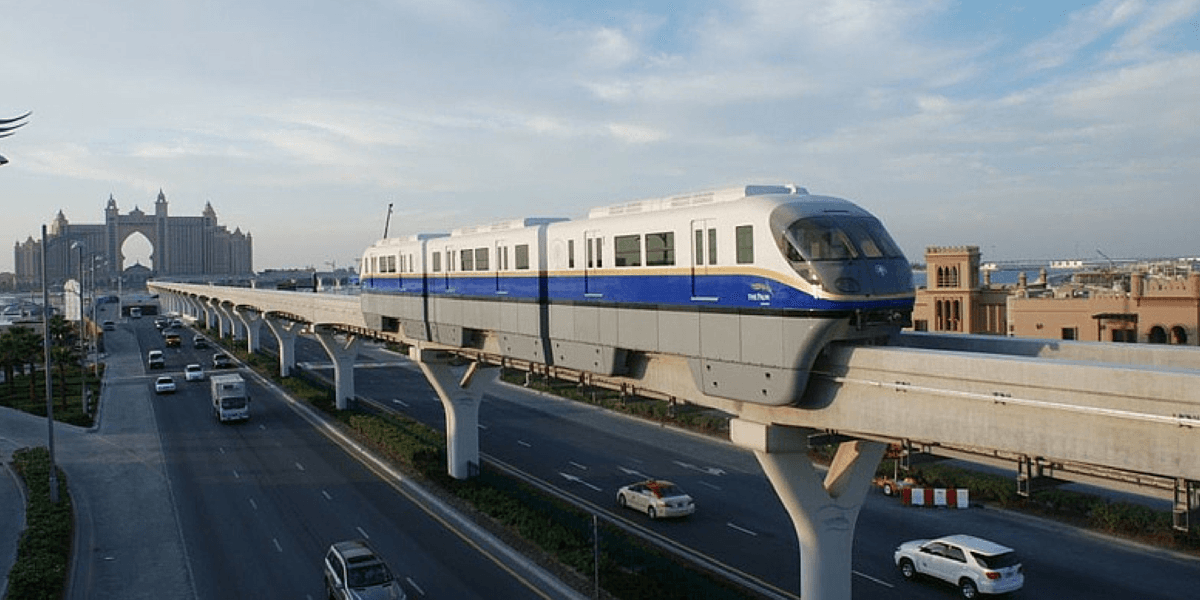
Stations
There are only two stations currently open but it has two other ones built but not open, and there is a planned extension for one more station.
The mentioned stations are:
Atlantis Aquaventure station – opened and it is only a few steps away from the famous Atlantis Resort with its magnificent Aquaventure Waterpark
Palm Mall station – closed since the mall is still under construction
Trump Tower station – closed as the developments nearby are yet to be completed
Gateway station – opened and this station is the connection to the Dubai Tram at its Palm Jumeirah station
Dubai Internet City (TECOM) station – closed, planned extension to connect the monorail to the red metro line
Although the Palm Mall and Trump Tower stations are closed, the train stops for a few seconds but the doors do not open.
Even though there is no direct connection to the metro yet, the monorail is quite easily accessible because of the Dubai Tram. From the Gateway station, you can go to the Palm Jumeirah tram station via a footbridge and in case you wish to continue your trip by the Dubai Metro, the tram links to the red line at two stations: Jumeirah Lakes Towers and Dubai Marina (new name: DAMAC) stations.
In case you travel by car and just want to try out the monorail you can leave your vehicle in a free parking lot for a quite large amount of cars (1500 parking spaces) at the Gateway station.
Timing
The monorail is open every day from 10:00 AM to 10:00 PM and it departures every 23 minutes.


The trip from the first and the last station takes around 10 minutes.
Tickets
Since the owner of the monorail is Nakheel and not the Roads and Transport Authority (RTA), the NOL card cannot be used on this railway.
Instead, there are two different types of ticket, and these can be bought at the monorail stations’ ticket machines.
You can only pay by cash, no credit or debit card is accepted and you must use your ticket on the same day as the purchase is done.
The single (one-way) ticket costs AED 15 while the return ticket is AED 25. Children under the height of 90 centimeters can travel for free. There are no other discounts available.
Tourists often ride the monorail despite its price because they can get an impressive elevated look of the Palm Island.
Bus
Dubai’s public transport bus system is quite large and has excellent facilities.
The bus fleet consists of more than 1400 buses, connecting the residential, industrial and business districts with more than 100 bus routes, serving thousands of people every week.
There are numerous bus stations, bus shelters and bus stops throughout the city. The buses are modern, clean, comfortable and cheap.
Bus features
The bus fleet consists of 170 double-deckers, 945 standard and 346 articulated buses. All the buses are produced at the highest security and safety standards, and they have great facilities with modern features, like:
- air-conditioning,
- low floors,
- wide entrances,
- comfortable seating,
- first few rows are generally dedicated for women and children only,
- designated spaces for passengers with physical disabilities,
- broad standing area,
- information screens,
- voice announcement of the next stop,
- passenger counting system,
- automated fare equipment (NOL card scanner).
Stations
Keeping with the standard of the buses, the stations are also modern and have the following features:
- air-conditioned waiting areas,
- designated areas and special service for women and children and passengers with physical disabilities,
- washrooms,
- prayer rooms for men and women also,
- cafeteria and beverages vending machines
- NOL card vending machines
- customer care centers
- parking spaces for bicycles and taxis.
Among the 2 main stations, there are 8 sub bus stations, 6 major feeder bus stations (for the metro), and there are plenty of bus stops available throughout the city. Most of the bus stops are also equipped with air-conditioned shelters. The above mentioned bus stations are:
- Main bus stations:
- Al Ghubaiba
- Gold Souq
- Sub-bus stations:
- Al Satwa
- Al Qusais
- Al Sabkha
- Deira City Centre
- Al Karama
- Al Qouz
- Union Square
- Al Jafilya
- Feeder bus stations:
- Abu Hail
- Al Rashidiya
- The Dubai Mall
- Mall of the Emirates
- Ibn Battuta
- Jebel Ali
- Intercity bus stations (outside the city):
- Sharjah
- Ajman
- Fujeirah
- Abu Dhabi
- Hatta
There are two high-tech depots available for the huge bus fleet’s maintenance (including operation and safety check-up), at Al Awir and Al Qusais.
Routes
The buses operate on over 100 bus routes including 48 local, 31 feeder, 8 express and 11 intercity bus routes. There are also 13 central business districts service routes (CBD) and Global Village and Miracle Garden bus routes as well as SKY Bus service routes (from Dubai International Airport to major hotels).
The currently available complete list of bus routes operating in Dubai:


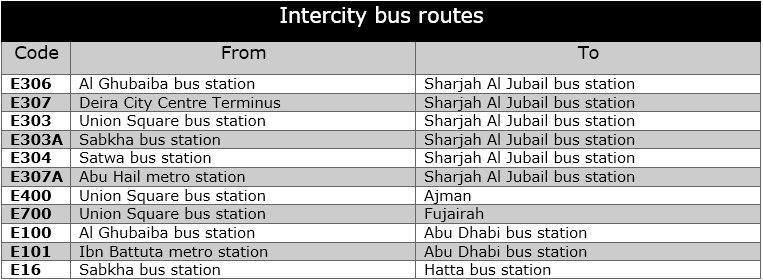


Connections
Dubai’s bus network covers a huge area (over 80% of the city) resulting in very good connectivity almost all over the city. There are many feeder buses that link the urban areas to the metro stations and there are numerous routes connecting the city’s major areas (see the lists above).
For the comfort of the tourists many hotels also offer shuttle buses to the popular shopping centers. Make sure to check it with your hotel once you reach your accommodation.
Beside all this, the SKY bus service has also launched its 12 routes, offering excellent direct comfortable bus rides between the Dubai International Airport and several most visited hotels in the emirate. Since it is an airport service, the buses are designed to handle baggages of all sizes.
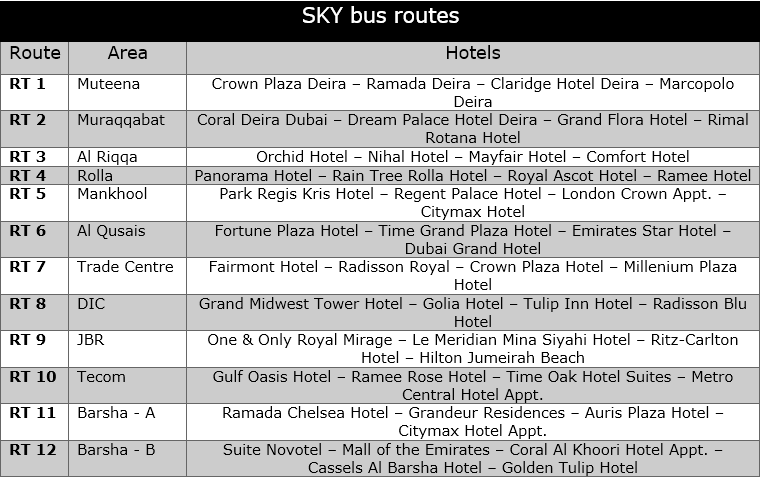
The bus leaves every 30 minutes and the trip takes about 40-60 minutes to pass by all the hotels on the chosen route.
Riding this shuttle bus requires the passengers to pay by NOL card which can be purchased and topped up at the hotels information desks and at the airport terminal kiosks.
No cash payment is accepted. The fare is AED 15 which includes free WiFi and light snacks and drinks on board during the journey.
Tourists can use this shuttle bus service for additional AED 15 for returning to the airport also after their holiday is over.
Timing
Buses run at regular intervals, more frequently (5-10 minutes) at the busier areas and less frequently (half an hour) at the other ones.
Generally they operate every day from 5 or 6 AM until midnight, while the Nightliner buses are active during the night from 11:30 PM to 6 AM. The metro feeder buses run every 5 to 10 minutes.
Fares
Just as the metro and the tram, the bus network is also operated by the Roads and Transport Authority (RTA), therefore the bus fares must be paid by the NOL card/NOL ticket.
No cash payment is accepted on the buses. The same things are applicable for the buses as for the metro or tram:
- Choose the right card/ticket for your trips (Red Ticket is ideal for tourists, Silver is for frequent travelers while the Gold is for those who wish to travel in VIP class).
- Purchase and top up the card or ticket with the sufficient amount before boarding the bus. You can buy these electric cards at the following bus stations: Al Ghubaiba, Gold Souq, Al Rashidiya and Al Satwa bus stations.
- Do not forget to scan your card as soon as you enter the bus.
- Do not leave the bus without scanning you card to check out.
- Your fare will be automatically deducted from your card according to the zones crossed during your journey (travelling within a zone can cost AED 3 with Red Ticket, AED 4 with Silver and AED 6 with Gold card while a journey within 3 zones can go up to AED 8.5 with Red Ticket, AED 7.5 with Silver and AED 15 with Gold Card)
- Your trip is free on the feeder bus after travelling by metro but the transfer time cannot be more than 30 minutes.
- If you wish to know more please visit the related content.
Rules
There are several instructions to keep in mind while travelling on Dubai Bus:
- Stay away of the bus stopping area at the bus stop.
- Signal the bus clearly to stop.
- Always board the bus using the front door and leave at the rear one. (Ladies and children can exit at the front door also.)
- Do not forget to scan your valid NOL card/ NOL ticket when entering, and then when exiting the bus. Using invalid, expired or other person’s card is forbidden.
- Keep the first three rows for female passengers.
- Animals are not allowed in any means of transportation, except guide dogs for people visually impaired.
- Eating (even chewing gum), drinking, spitting, littering and smoking is not allowed.
- Do not bother others with listening to loud music.
- Please refrain from acts which could disturb or distract the driver.
- Keep the gangway free and do not place your luggage there.
- Selling or promoting goods is prohibited.
- It is not allowed to carry alcohol and hazardous items.
- Vandalism is strictly prohibited.
- If you wish to get off the bus, please do not forget to press the bells on time and wait until the bus stops at the bus stop.
- Using the emergency door is forbidden unless permitted or instructed by the driver.
- Leaving without payment will result in fine.
- Sleeping in bus shelters is forbidden.
Future plans
Due to the growing population and plenty of tourists, it is common that passengers might have to wait more than half an hour at the busy areas.
The Dubai Government is continuously working on measures to improve the public transport system in Dubai. One of their plans is to extend the existing metro lines and building new ones
. As these new metro stations get operational the bus routes also might change accordingly so please double check the route you will take on the official website.
Water transport
Dubai has an excellent marine transportation network. There are several types available. You can try out the traditional wooden boat: abra along the Dubai Creek or catch the air-conditioned water bus. Choose between the Dubai Ferry and the luxurious water taxi or if this is not enough, you can also opt for the one of a kind, fun Wonderbus.
Abra
The Dubai Creek between Bur Dubai and Deira is a hidden gem in the city. If you are near this area just hop on an abra and enjoy the glittering view of numerous pigeons and seagulls flying over many cruise ships, dhows and cargo boats docked at both sides of this historical site of the city.
The abra is a small, traditional wooden boat equipped with engine and used to ferry passengers across the Dubai Creek. One of the oldest modes of transportation’ fleet consists of more than 100 abras and each has a maximum capacity of carrying 20 people at a time.
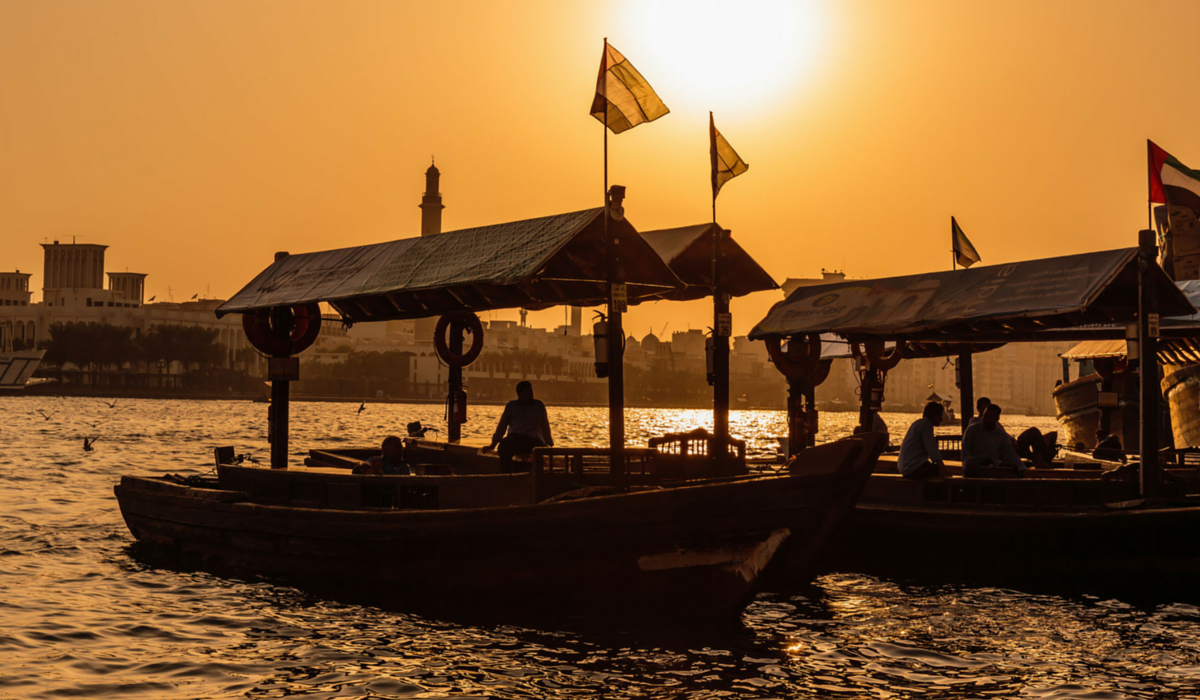
Stations
These tiny wooden boats travel between Bur Dubai and Deira in two different routes and 4 different stations.
- Route 1 runs between Deira Old Souk station (on Baniyas Road near Deira spice souk) and Bur Dubai station (near Al Ghubaiba bus station).
- Route 2 runs between Al Sabkha station (on Baniyas Road near Deira gold souk) and Dubai Old Souk station (near textile souk).
Timing
Abra operation times are long, the boats run from 5:00 AM to 12:00 AM midnight every day on Route 1 while they operate 24 hours daily on Route 2.
The abras usually depart every 20 minutes or as soon as all the seats have been filled. The single journey takes 5 minutes (0.59 kilometers) on Route 1, and 7 minutes (0.68 kilometers) on Route 2.
Fares
Crossing the Dubai Creek by abra is extremely cheap, it costs only AED 1 per person per trip in case of travelling within the given routes. You can also hire this traditional boat for an hour or more for a higher price (usually around AED 100).
Using this tiny and noisy boat is not only a very affordable and quick way to travel between Bur Dubai and Deira, but it is also a pleasant way to experience a little past of this modern city.
Water bus
Dubai is a waterfront city and traveling by water transport has some great benefits. It is better for the environment and has better safety standards than traveling by car.
Because of all this, the Marine Agency at Roads and Transport Authority (RTA) has launched a smooth water transit service across the Dubai Creek and Dubai Marina.
These water buses are air-conditioned, electric boats with luxurious seats, providing a comfortable and unforgettable experience to its passengers (maximum capacity: 36 people per boat).

Routes
The water buses operate in 2 areas in the city: in Dubai Creek and Dubai Marina.
The Creek route covers five marine stations:
- Al Seef
- Baniyas
- Al Sabkha
- Bur Dubai
- Al Ghubaiba
The modern air-conditioned boats are available every day, but the timing is different. They run from Saturday to Thursday from 7:00 AM to 10:00 PM while the operating hours are shorter on Friday and during public holidays, from 10:00 AM to 12:00 AM (midnight). The water bus departs every 15 minutes and the 12 minutes trip costs AED 2 per trip per person.
The Dubai Marina route covers four marine stations:
- Marina Walk
- Marina Terrace
- Marina Promenade
- Marina Mall
Passengers can use the water bus every day in Dubai Marina also, just like in Dubai Creek, although the operating hours are different. The water buses run from 10:00 AM to 10:00 PM from Saturday to Wednesday, from 10:00 AM to 12:00 AM (midnight) on Thursday and from 12:00 PM (noon) to 12:00 AM (midnight) on Friday and during public holidays. The boats leave every 15 minutes.
The Dubai Marina route fares differ from the Dubai Creek route fares. The ticket costs between AED 3 and AED 5 depending on the chosen trip length (7-9 minutes trips).
Passengers have to pay AED 3 for traveling from Marina Walk to Marina Terrace or from Marina Mall to Marina Promenade while AED 5 for a journey from Marina Walk to Marina Mall.
There are special water bus services also available for tourists. They can opt for a longer journey by choosing the separate hop on hop off route with a daily pass for a higher price: AED 50 for adults and AED 25 for children.
Since the water buses are operated by the Roads and Transport Authority (RTA), the fares have to be paid by using the NOL Card or NOL ticket.
No cash, debit or credit card payment is accepted on the water buses. You can get to know more about the NOL Cards, fares, and passes at the related content: NOL card.
People with special needs
There is a Customer Service Office at each station with a qualified employee to provide full support for passengers with physical disabilities, like ticket, boarding the boat and seating onboard.
Please report to the Customer Service Office for their assistance.
Taxi
Among transportation types, travelling by taxi appears the most beneficial mean of transport despite their price.
- It is available 24 hours daily and seven days weekly, they even operate during public holidays.
- The taxis are available almost at all public places in Dubai.
- It is a very effective way to reach any destination – no fixed point to look for (like a bus or metro station), no waiting time (like timetable).
- Usually, they are faster than any other transportation, especially if you travel to such places which are not well-connected by metro or bus (of course except during peak time).
If you choose to travel by taxi, you won’t have a problem with getting one as there are hundreds of cabs available throughout the city.
The registered cabs have ‘TAXI’ lights on the roof which indicates the current status of the taxi: red light means it is occupied while the green or yellow light shows that the cab is available.
The official taxis are clean, comfortable, relatively cheap and equipped with air conditioner. The drivers are generally friendly, and most of them talk in a mixture of different languages: English, Hindi and Arabic.
Dubai taxi companies
The officially registered taxis are operated by the Dubai Taxi Corporation, which licenses other private taxi operators. All these cabs have the same beige body color while their roof varies according to the taxi company.

After choosing the company, you still can specify what type of taxi you request.
You can order pink taxis driven by female drivers which are dedicated to ladies and family groups only, or you can book special taxis for people with disabilities.
There are also heavy transport carriers and VIP luxury cars available for the customers, and you can hire a taxi for a longer period, like 6 or 12 hours as well.
Dubai taxi rates
Compared to other major cities, taxis are relatively cheap in Dubai due to the affordable petrol price. The taxi rates are based on the meter installed in the car which operates on distance travelled basis (not time).
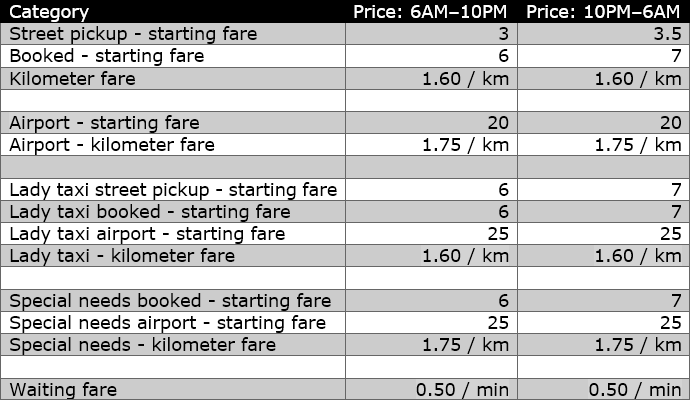
Please note that the minimum taxi fare in Dubai is AED 10, in the case of crossing toll gates (Salik) AED 4 will be automatically added to the taxi meter while crossing emirate’s border you will be charged with extra AED 20, and your journey is free if the running meter is not operating.
Anytime you travel by taxi be prepared to carry cash since many of them prefer cash, but in case you don’t have money in hand don’t panic, just make sure before you get in or while booking that the requested taxi accept your debit or credit card.
How to book a taxi in Dubai
There are different ways to hire a taxi in Dubai.
- One of the most popular ways to catch a cab is to flag it down on the street. Generally, they can be found almost everywhere throughout the city. Hundreds of them will be waiting at their own taxi stand, outside the airport, near metro stations or right next to the malls.
- The other common way to hire a taxi is to book it via phone call, for phone numbers, please see the chart above. You can expect around 5-30 minutes waiting time till the taxi arrives at your doorstep.
- If you are travelling by metro and about to hire a taxi once you reach the final station of your journey, you can easily avoid waiting time by sending an SMS to 4774 with your station code (example: R25A – R: red line, 25: station number, A: A entrance).
- Smartphone users can book a taxi via their device as well if they have the RTA Smart Taxi application downloaded on their phone. The app uses the passenger’s location and sends a nearby taxi there, and this progress can be followed by the application itself.
Tips for using taxi in Dubai
- There is no shortage of taxis throughout the city, but you can expect fewer taxis at the old site of the city: near metro stations in Bur Dubai, at Karama shopping area and the water taxi stations in Deira.
- You can experience longer waiting time at major shopping centers, especially on Thursday and Friday.
- Although taxi drivers are not allowed to refuse any trip even if the journey is quite short, sometimes they do refuse.
- Use official, registered beige colored taxis only, the others are illegal and more expensive.
- As per the custom in the Middle East, ladies always should sit in the rear of the vehicle to avoid misunderstanding.
- Due to the newly implemented address system, taxi drivers often get confused (mostly the new ones), so it is best either to carry a small map or, at least, to know the nearest landmark’s name in case you are not sure how to get to your destination. Most of the drivers will know for example hotels, main roads, stores, tourist attractions, so it is recommended to mention one of these to specify your destination.
- Taxi drivers like to speed especially on highways. If you feel uncomfortable, just ask them to slow down.
- All official taxis have the same rules clearly visible on a sticker on their window, and they also have a complaints number in case you have something to report.
- It is advisable to remember the taxi’s specific number (written somewhere at the back passenger door) which can be very helpful in case you leave your belongings in their vehicle.
- Most of the taxis prefer cash so try to carry some money in hand (preferably smaller notes) or make sure in advance that they accept your credit or debit card.
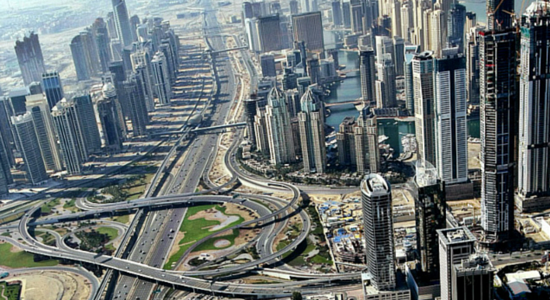

Driving in Dubai
As it is written above, the broad highways are marked with E and the streets are marked with D.
The city’s road sign system is easily understandable: the blue and green signs point out the roads, exits and locations out of the city, while the brown ones indicate places of interest and hospitals.
There are a large amount of traffic lights and plenty of speed bumps and roundabouts throughout the city which makes the traffic slower but the whole town safer.
A satellite navigation system (GPS) can help you find your way but only to a certain level because of the newly implemented address system (renamed streets) and the numerous of construction work.
As you plan your day, schedule an extra 20-30 minutes for getting lost as most of the highways and streets are one way, and you probably will have to take U-turns to get back on the right track.
Traffic jams can make your day longer also, but you can try to avoid the heavy congestions if you are aware of their timing: in the morning from 7 AM to 9 AM, noon time from 12 PM to 2 PM and in the evening from 5 PM to 8 PM.
Petrol stations and parking
Driving in Dubai is quite affordable due to the cheap petrol which is on average of AED 1.7 per liter.
Although throughout the city you will find different petrol stations (like Emarat, ENOC or EPPCO), you don’t have to roam around to find the cheapest as all of them has the same price.
All the stations are handled by the company’s employees itself who will fill your car with petrol and clean the windscreen for you upon request.
In most places other services are available also such as car wash, oil change or tire replacement and some of them have fast food restaurants or cafes as well.
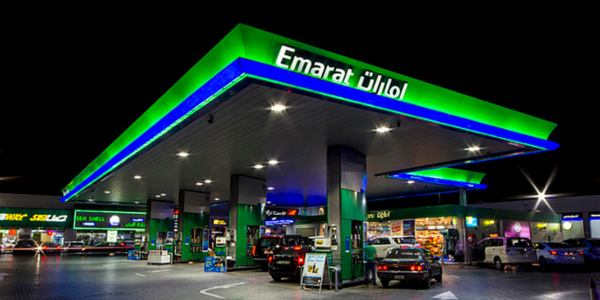
Most commercial areas in Dubai require you to pay for the duration of your parking via parking meter (orange ticket machine).
As in other cities as well, you have to pay by coins and the given card must be placed on the dashboard in your car. Rates start at AED 2 per hour, and the longer you park your vehicle, the more you pay.
In general, parking is free during lunch time from 1 PM to 4 PM, at night from 9 PM to 8 AM, on Fridays and during public holidays.
Several areas have more, different type of payment system: at parking lots attached to metro stations you can use your NOL card while the mParking system allows you to pay via SMS.
Road rules within the United Arab Emirates
- The roads are designed for left-hand drive vehicles, means that you have to drive on the right side of the road and take over on the left.
- Wearing seatbelt is mandatory.
- Always keep your driving license and vehicle registration card in the car otherwise you can be fined by police.
- Children below age 12 are not allowed to sit in the front seats.
- Speed limits are usually 60 or 80 km/h on city roads while on highways 100 or 120 km/h – they are clearly marked on boards.
- On highways, the minimum speed limit is 60 km/h.
- Highways and major roads are controlled by speed radars.
- Tailgating is not allowed in any circumstances.
- Jumping of red light and driving on hard shoulder are not permitted and will be fined.
- Using phone (without hands-free) is not allowed while driving.
- The region has strict zero-tolerance policy on drinking and driving, and it probably will result in jail.
- Using offensive gestures may result in fine or even in jail.
- If you are involved in a traffic accident, it is mandatory to call the police and collect the police report.
Fees and fines
In case you have to use the busiest motorway in Dubai (Sheikh Zayed Road) during your drive, you should be aware that there are six toll gates, and anytime you cross one you have to pay AED 5.
Despite all that, if you drive through Al Safa and Al Barsha toll gate in one trip within half an hour you will be charged only once.
In case you break any rule in the UAE be aware of some of the fine ranges:
- Not having parking ticket or staying longer as per ticket: starts at AED 100-150.
- Driving with higher speed than the limit is: starts at AED 400.
- Racing with car: AED 2000.
- Driving in bus and taxi lanes: AED 600.
- Drinking and driving: jail.

Breakdown and accident
It is always wise to be prepared for any breakdown during driving.
If it happens, you are required to pull the car over to a safe spot and wait far away from the road till help arrives. Most of the car rental companies offer 24-hour assistance for this kind of incident and will help you out with your issue.
Even if you are confident enough to drive a car in Dubai, you have to keep in mind that drivers might have aggressive habits and do dangerous manoeuvres on the roads just like in any other big metropolis so always be cautious while driving.
If after all, your hired car is involved in an accident, the following things must be done:
- Call 999 to get advice and help on what to do.
- If the incident is minor and no one is hurt, first pull over your car to a safe spot and discuss with the other driver who is to be blamed. If it is not clear, an officer will help you out to decide.
- Most probably you have to drive to the police station to get the accident report then they will guide you about the further process.
- Don’t forget to inform your car rental company about the incident.
Emergency services
- Police: 999
- Fire department: 997
- Ambulance: 999
Dubai International Airport: DXB
The Dubai International Airport is not only one of the busiest airports in the world with around 75 million passengers annually but also known for its huge cargo traffic. The airport officially opened in 1960, and it was expanded gradually within the years serving more and more flights. This huge building is situated on the North side of the city near Dubai Creek, very close to the Sharjah emirate and it is operated by the Dubai Airports Company.
Terminals
The airport has four terminals from which three terminals are handling the passenger traffic and one the cargo service:
- Terminal 1 – is mainly used by major international airlines and has a capacity of 22 million passengers
- Terminal 2 – is serving Flydubai, regional low-cost airlines and charters routed to airports in the Middle East and Eastern Europe with the capacity of 10 million passengers
- Terminal 3 – is the hub for Emirates Airlines and Qantas and it is capable of handling 43 million passengers
Airport facilities
- Immigration processing facilities
- Baggage services
- Customs
- WiFi
- Banking service, ATM, money exchange
- Post Office
- First class and business class lounges
- Business centers, conference and meeting rooms
- Medical Center
- Prayer rooms
- 24-hour shuttle buses between terminals
- Greeting service
- Short and long-term parking facilities
- Car hire
- Tourist information desk
- Restaurants and cafes
- Large duty-free centers
- Baby care rooms and children’s play area
- Snoozecubes
- Shower cubicles
- Swimming pool, jacuzzi, sauna, spa, gym
- Two open-air gardens
- 4* and 5* hotels
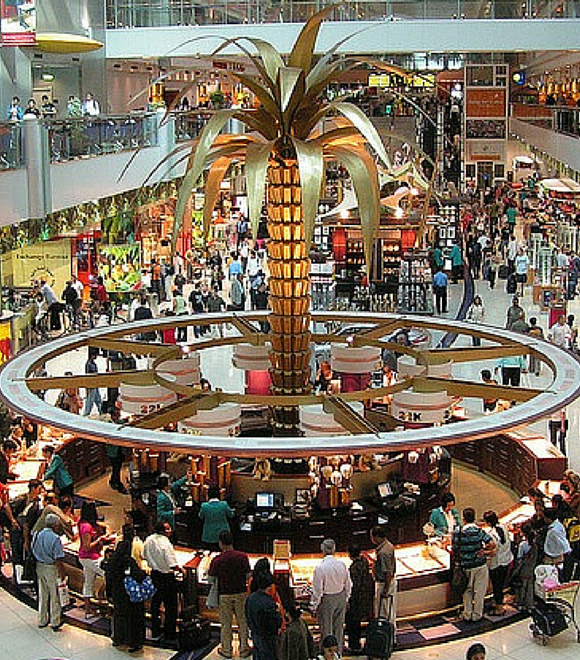
Transportation at the airport
As soon as you land in Dubai, you have several options to choose from regarding transportation. If you have an international driving license, you can hire a car, or you can choose between taxi, metro and bus to reach your destination.
- There are various car rental companies offering their service at the airport including AVIS, Dollar Rent a car, Thrifty and many more.
- The most popular way to get around in the city is the taxi, and they are available 24 hours daily. You can either book it in advance or just flag down one from the hundreds of cabs waiting outside the airport. The starting taxi fee from the airport is AED 20-25 and AED 1.75 per kilometer till you reach your destination.
- The red line Dubai Metro has two stations crossing by the airport, at Terminal 1 and Terminal 3. You can purchase your ticket (NOL card) at any of the stations. Please note that you are allowed to carry only one big suitcase and one hand luggage on the metro trains.
- Another low-cost option to travel within the city is the bus. If you choose this option, keep it in mind that you have to purchase NOL card before using this service. There are many buses available, going to different directions from the airport but mainly to Deira side.
- If you have to transfer between terminals within the airport shuttle bus service is available frequently.
- The SKY bus service has also launched its 12 routes, offering excellent direct comfortable bus rides between the Dubai International Airport and the most visited hotels in the emirate. Riding this shuttle bus requires the passengers to pay by NOL card which can be purchased and topped up at the hotels information desks and at the airport terminal kiosks. The fare is AED 15 which includes free WiFi and light snacks and drinks on board during the journey. Tourists can use this shuttle bus service for additional AED 15 for returning to the airport also after their holiday is over. If you are interested about the routes, you can find the details at the related content.
The airport also has car parking for short and long term as well. The cost of parking starts at AED 10 and goes up to AED 240 depending on the duration.
Al Maktoum International Airport: DWC
The Dubai World Central – Al Maktoum International Airport is located on the other side of the city: in Jebel Ali
. The first passenger plane landed here in 2011, but the airport officially opened only in 2013 with the first flights of WizzAir and Nas Air.
Currently, the airport operates with low-cost airlines and cargo flights only but in the future, this airport is expected to be the largest airport in the world with around 160 million passengers and 12 million tons of yearly cargo capacity.
Airport facilities
- Immigration processing facilities
- Baggage services
- Customs
- WiFi
- Banking service, ATM, money exchange
- Greeting service
- Prayer rooms
- Car parking
- Car hire
- Restaurants and cafes
- Duty-free center
- Shopping outlets
- Shower cubicles
- Marhaba Lounge
Transportation at the airport
Just as the Dubai International Airport, DWC also has various options of transportation to reach your next destination. These are the following:
- The Al Maktoum International Airport has car rental companies available as well including AVIS, Europcar, Hertz or Thrifty.
- You can also choose to go to your destination by taxi which will cost you AED 1.75 per kilometer and most probably an extra AED 20-25 as airport charge.
- The airport is linked to the city and the other airport by bus. The bus number is F55, and it is operating in every hour. As it is written above, you will need a purchased NOL card to use this public transportation.
Unfortunately, none of the metro lines are linked to Al Maktoum International Airport(DWC) , so you have to pick a taxi or bus to reach the nearest metro station: IBN Battuta Mall.
The airport’s parking has a capacity of around 800 parking lots, and there is no fee for leaving the car there.
